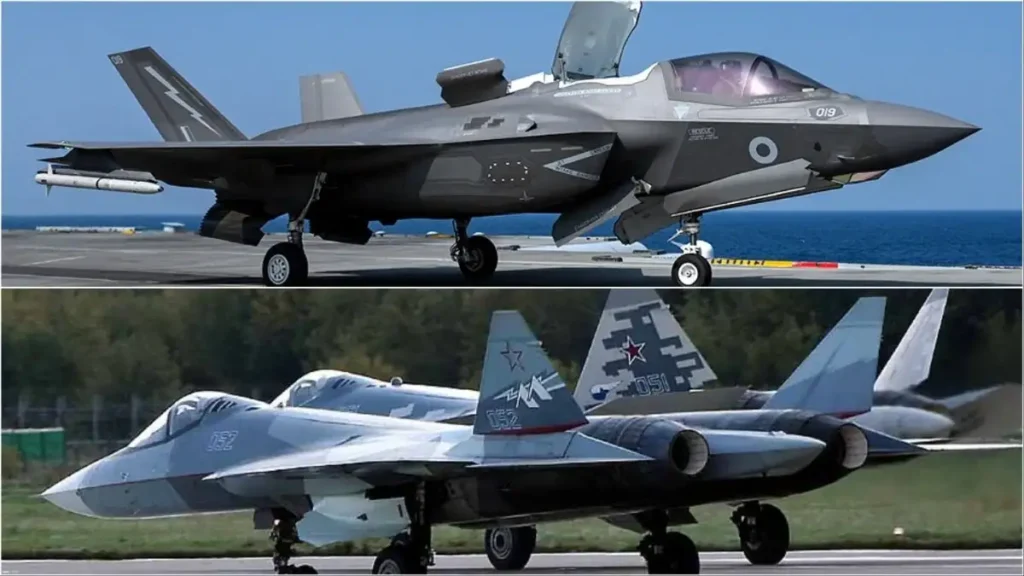F-35 vs Sukhoi Su-57: Is It Time for India to Invest in Stealth Fighters – Which Jet Reigns Supreme?
As military aviation advances rapidly, stealth technology has become a key factor in air combat. For India, which faces growing challenges from neighboring countries, acquiring stealth fighters is becoming essential. Among the leading options are the American F-35 and the Russian Sukhoi Su-57. Both are fifth-generation jets but differ in many ways. So, which one would suit India better?

This article explores their features, strengths, and what they could mean for the Indian Air Force (IAF).
Why Does India Need Stealth Fighters?
India’s security situation is complex, with tensions along its borders involving China and Pakistan. The IAF has been modernizing its fleet by acquiring jets like the Rafale. However, future combat scenarios demand aircraft that can evade radar detection.
Stealth fighters reduce the chance of being detected and targeted. Consequently, they offer a major advantage by enabling deep strikes and improved survivability. Therefore, acquiring stealth jets is critical for India to maintain air superiority and deter potential threats.
The F-35 Lightning II: America’s Advanced Stealth Fighter
The F-35, developed by Lockheed Martin, is a versatile stealth fighter. It excels in air combat, ground attacks, and intelligence missions.
Speed and Maneuverability:
The F-35 can reach speeds up to 1,931 kilometers per hour. While not the fastest, its speed is adequate for most combat situations. More importantly, it emphasizes stealth and sensor capabilities over raw velocity.
Cutting-Edge Stealth Technology:
Its design minimizes radar detection. In addition, the F-35’s advanced electronic warfare systems increase its survivability. The jet’s sensors provide pilots with a detailed, real-time battlefield view. This improves decision-making and situational awareness.
Global Network and Support:
If India acquires the F-35, it would join a network of allied countries operating the aircraft. This could enhance joint operations and training. However, U.S. export controls might limit India’s access to some sensitive technologies, affecting operational independence.
The Sukhoi Su-57: Russia’s Agile and Fast Stealth Fighter
Russia’s Su-57 aims to combine stealth with speed and agility, offering a different approach compared to the F-35.
Speed Advantage:
The Su-57 reaches a top speed of around 2,137 kilometers per hour, making it faster than the F-35. This speed allows for quick strikes and rapid repositioning during combat.
Stealth and Maneuverability:
While the Su-57 features stealth elements like internal weapons bays and radar-absorbent materials, it focuses more on agility and electronic countermeasures. Its thrust-vectoring engines enable exceptional maneuverability in dogfights.
Flexibility and Technology Sharing:
Russia is open to exporting the Su-57 with more generous technology transfer options. This could be appealing to India, which prefers greater control over its defense equipment for future upgrades and customization.
Comparing the Jets: Which One Fits India’s Needs?
Choosing between the F-35 and Su-57 involves more than just technical specs. Geopolitical factors, costs, and integration with existing forces also play major roles.
Geopolitical Dynamics:
India has a long history of defense cooperation with Russia. Recently, however, relations with the United States have strengthened. Purchasing the F-35 could boost ties with the U.S. but might strain the Russia partnership.
Technological and Operational Considerations:
The F-35’s stealth and advanced sensors align well with India’s push toward a network-centric military. Conversely, the Su-57’s speed and maneuverability could complement India’s current aircraft. Also, the Su-57’s flexible technology sharing offers potential benefits.
Cost and Maintenance:
The F-35 comes with a high price tag, including maintenance and software updates. In contrast, the Su-57 might be more cost-effective and easier to maintain, benefiting from existing India-Russia logistical channels.
The Future of India’s Stealth Fighter Fleet
India is developing its own stealth fighter, the Advanced Medium Combat Aircraft (AMCA), but it won’t be operational for several years. Meanwhile, acquiring a ready stealth platform is crucial to keep pace with regional threats.
Both the F-35 and Su-57 represent significant advancements. The F-35 offers superior stealth and integrated warfare capabilities. On the other hand, the Su-57 delivers greater speed and flexibility.
Ultimately, India’s decision will balance geopolitical partnerships, technological goals, and operational demands. One thing is certain: stealth technology will define the future of air combat, and acquiring such jets is essential for India’s security.






